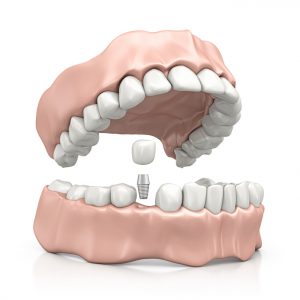 Dental implants are now widely used to replace the root of a missing tooth, which allows for a prosthetic tooth to be placed onto the extension post. Dental implants are now the preferred option to replace missing teeth because they offer a lifelong solution. Not to mention, when compared to other forms of tooth replacement, the benefits of dental implants far exceed those of any other. While dental implants are effective and highly preferred, it does involve a surgical procedure. As a dentist for dental implants in Boca Raton, Gerard Cuomo explains the surgery needed to receive dental implants.
Dental implants are now widely used to replace the root of a missing tooth, which allows for a prosthetic tooth to be placed onto the extension post. Dental implants are now the preferred option to replace missing teeth because they offer a lifelong solution. Not to mention, when compared to other forms of tooth replacement, the benefits of dental implants far exceed those of any other. While dental implants are effective and highly preferred, it does involve a surgical procedure. As a dentist for dental implants in Boca Raton, Gerard Cuomo explains the surgery needed to receive dental implants.
(more…)
Surgery for Dental Implants in Boca Raton
September 25, 2016
Dental Implants: The Best Solution for Missing Teeth
July 22, 2016
 When it comes to treating tooth loss, you have a lot of options. But, what is the best option? While dentures and dental bridges have held a common place in tooth replacement for decades, they are no longer the most preferred option. Now, dental implants are the most preferred solution for tooth loss because they offer a permanent solution that promotes oral health. When compared to other forms of tooth replacement, dental implants offer unmatched benefits that just aren’t possible with other dental prosthetics. As your dentist for dental implants in Boca Raton, we have the facts you need to know about the best tooth replacement option.
When it comes to treating tooth loss, you have a lot of options. But, what is the best option? While dentures and dental bridges have held a common place in tooth replacement for decades, they are no longer the most preferred option. Now, dental implants are the most preferred solution for tooth loss because they offer a permanent solution that promotes oral health. When compared to other forms of tooth replacement, dental implants offer unmatched benefits that just aren’t possible with other dental prosthetics. As your dentist for dental implants in Boca Raton, we have the facts you need to know about the best tooth replacement option.
(more…)
Why do dental implant screws loosen and fracture after a prosthesis is placed?
May 3, 2013
I feel that foreign matter plays a role in contamination of not only the implant fixture threads, but also the implant screw threads. This foreign matter is comprised of blood (body), calculus (body), wax (lab), porcelain powder (lab), metal filings(lab), and stone slurry (lab). I also feel that the screw head may not seat properly in the screw access hole of the screw abutment, crown, and/or bridge prosthesis due to the same contaminants.
Screw loosening/fracture occurs:
1. When dentists and labs don’t recognize this debris as a contaminant.
2. The dentists and labs don’t use a new/unused screw for the final screw.
3. The proximal contacts of the crown and bridgework are too tight, putting excessive lateral pressure on the screw threads.
4. Calculus formation in the threads of loose screws will inhibit the dentist’s ability to remove the screw without fracture.
5. Screw metal surface quality may play an important role. You need to check with the implant manufacturers.
Presoaking the screw access hole with tarter/stain removing solution is my best advice for existing cases. Lab quality control starts with using advanced magnification such as a quality dental microscope. GC
Reaching out to dental students across the nation via YouTube
May 2, 2013
Thank you very much for you fit check videos – I think if every dental student watched them and applied the level of detail that you do then the worldwide quality of dentistry would improve drastically!
Thanks for all of your videos – I think they are some of the most informative dental videos on YouTube.
All-on-Four Fixed Implant Denture – "A cost effective alternative to wearing a complete set of removable dentures"
August 12, 2012
End stage dentistry does not have to end with a complete set of removable dentures. Now there is a unique treatment concept that will return a patient’s vitality for chewing food and help them avoid embarrassing moments associated with wearing dentures. It’s known as the “All-on-Four” technique with same day loading. Same day loading or “Immediate Loading” allows the patient to never be without teeth. Patients walk into the dental office with removable dentures and two to three hours later walk out with fixed implant non-removable dentures that they can call their own. Please click on the following link to watch one of our many videos on the “All – on – Four” method. GC
http://www.youtube.com/watch?v=yyqMxvV9SCw&list=UUZFBuQ_o3n2JTDSR2hj3TTg&index=1&feature=plcp
http://www.youtube.com/watch?v=oyegukONiZA&list=UUZFBuQ_o3n2JTDSR2hj3TTg&index=9&feature=plcp
CAD/CAM Dentistry – Computer-Aided Design and Computed-Aided Manufacturing in Dentistry
December 18, 2011
Old School vs. New School . . . CAD/CAM technologies produce different types of dental restorations, including crowns, inlays and onlays, veneers, fixed-bridges, implants, and orthodontic appliances. These restorations are milled from solid blocks of ceramic and titanium materials. Computer images are either captured by hand-held devices which scan directly in the mouth or desk-top which scan images outside the mouth. The images are sent to the computer software where they are interpreted and set up for design. At this point, the designers are either going to be your dentist, dental assistant, or dental laboratory technician depending on the system being used. The virtual images are sent to the milling center where the final restorations are produced. For further information, feel free to visit the following sites: http://www.3shape.com/why-3d-design/software-videos.aspx , http://www.cadent.biz/ GC
Use of a Water Flosser for Interdental Cleaning
December 11, 2011
Interdental cleaning is an important part of a patient’s personal oral care regimen. Water flossers, also known as oral irrigators (WaterPik), can play a vital, effective role in interdental hygiene. Evidence has shown a significant reduction in plaque biofilm from tooth surfaces and the reduction of subgingival pathogenic bacteria from pockets as deep as 6 millimeters with the use of water flossing. In addition, water flossers have shown to reduce gingivitis, bleeding, probing pocket depth, and tartar buildup related to dental implants, porcelain veneers, crowns, orthodontics, as well as natural teeth. GC
New Patient Experience
November 6, 2011
The New Patient Exam (as well as all hygiene visits) should include an Oral Cancer Exam. It is painless and quick – it takes only a few minutes. The following questions should be answered for an effective oral head and neck cancer screening to take place.
Did your dentist —
-
Ask you to removal of any dentures (plates) or partials prior to examining your mouth?
-
Inspect your face, neck, lips, and mouth for any signs of cancer?
-
With both hands, feel the area under your jaw and the side of your neck, checking for lumps, bumps, or bruises that may suggest cancer?
-
Look aand feel the insides of your lips and cheeks to check for possible signs of cancer, such as red and/or white patches?
-
Have you stick out your tongue so it can be checked for swelling or abnormal color texture?
-
Use gauze to gently pull your tongue to one side, and then the other, to check the base and underside of your tongue?
-
Look at the roof and floor of your mouth, as well as the back of your throat?
-
Put one finger on the floor of your mouth and, with the other hand under your chin, gently press down to check for lumps or sensitivity?

